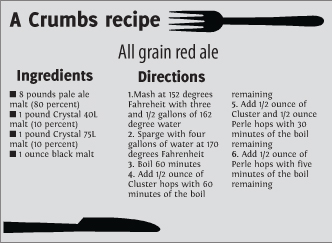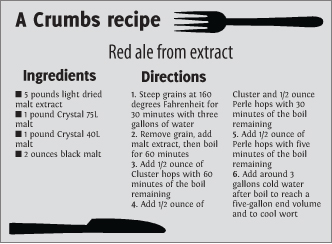Silas Whitley | Crumbs
Beer Comparison
This week, I compared two red ales: Laurelwood Brewing Company’s “Free Range Red” from Portland, Oregon, and Pike Brewing Company’s “Kilt Lifter” from Seattle, Washington.
Red ales and amber ales are roughly similar and are discerned by the amount of redness in the brew. To get the red color, add one to two ounces of black malt or other dark grain per each five gallon batch.
Both beers were the same price at $1.49. The Laurelwood brew was less alcoholic at 6.1 percent alcohol by volume compared to the Kilt Lifter at 6.5 percent alcohol.
The Kilt Lifter had a sweet flavor, possibly due to a fault in the beer like the presence of diacetyl, which causes a “butterscotch” taste. Overall though, it was smooth and had nice carbonation and was not significantly hoppy.
The Free Range Red was sweet and finished an almost metallic taste. This might be due to the hops. This brew was somewhat hoppy and pretty similar to a pale ale. It finished a little yeasty and had some sediment.
The two beers were pretty different except in color. I can’t say I enjoyed either of them a whole lot, and I would probably stick with an even cheaper option, George Killian’s Irish Red, at the end of the day.
Works in Progress
On Tap: Stout, red ale
Bottles: Red ale, pecan red ale, gingerbeer
Primary fermenting: Nothing
Secondary fermenting: Strawberry blonde ale
Queue-to-Brew: IPA, pilsner
Homebrewing Tips
During extract brewing, make sure to add the extract (particularly dried extract) slowly to the boil. Fast additions–in my experience–tend to boil over. When boiling wort, do not cover it. This can also cause over-boiling, but more importantly, boiling cooks out compounds that are undesirable in finished beer, like dimethyl sulfide (DMS), and releases it in steam. Covering boiling wort does not allow DMS and other things to be removed, but instead traps it and lets it drip back into the wort. The same methodology applies to cooling wort. Do not cover cooling wort because things like DMS are still being removed.
If doing an all-extract brew, an hour of boiling time is not necessarily needed. Most, if not all, extracts have been processed enough to remove things like DMS. It is still advisable to boil all-extract brews for at least 30 minutes. Besides, hop utilization depends partly on length of time the hops are boiled.
And a commonsensical tip: don’t add hot wort to a cool glass carboy. Allow your cooling wort to cool at least below 80 degrees Fahrenheit before adding to a carboy or adding yeast, as this will prevent oxidization of wort, yeast temperature shock, and a huge surprise of a shattered carboy.
Homebrewing Recipe: Red Ale
Cool either recipe as quickly as possible. Do not cover when cooling. Ferment either recipe for no more than 10 days using an ale yeast, then decant of the sediment into another sanitary fermenter and let sit for at least another 10 days.
Silas Whitley can be reached at [email protected]





